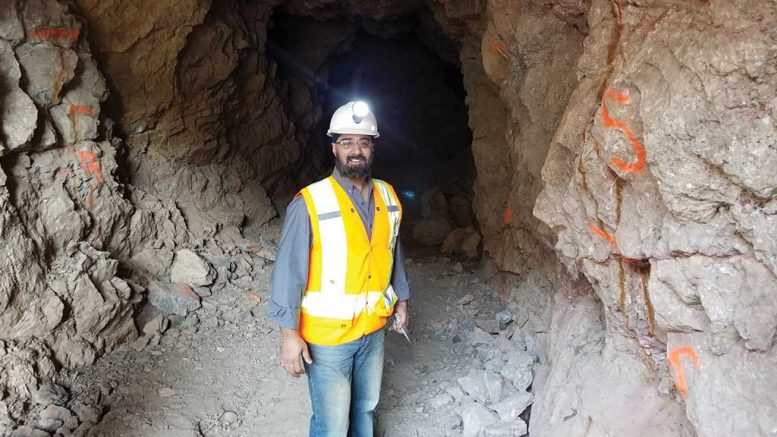Discovery Metals (TSXV: DSV) has fielded results for 100 new channel samples taken from the historic Zaragoza zinc-silver-lead mine on its 300 sq. km Puerto Rico polymetallic property in northern Coahuila, Mexico. Discovery has taken 600 samples at Puerto Rico to date, and plans to finish as many as 1,400 before drilling the property late in the third quarter of 2018.
Samples include: 2 metres grading 822 grams per tonne silver, 2.1% zinc, 2.5% lead and 0.7% copper, with less than 1 metre at 1,675 grams silver, 2.2% zinc, 4% lead and 1.1% copper, as well as 3.3 metres grading 175 grams silver, 2.1% zinc, 15.2% lead and 0.2% copper.
Discovery went public in August 2017 with the Puerto Rico polymetallic project as its flagship asset. It operates under the Oxygen Capital banner along with Liberty Gold (TSX: LGD), Pure Gold Mining (TSXV: PGM) and Sun Metals (TSXV: SUNM).
Discovery has a cluster of seven properties in Coahuila.
“We look for data-rich projects that have been past producers or that have had other operators,” Discovery president and CEO Taj Singh says during a telephone interview with The Northern Miner. “Because there was so much historic production it allows us to get right up to the mineralization and start sampling it.”

Oxidized, mineralized breccia at the surface of Discovery’s Minerva property. Credit: Discovery Metals.
Puerto Rico has seen more past production than any of the company’s other properties, and has three historic mines. It was mined by Kansas City Smelting from 1896 to 1900 and by Asarco from 1906 to 1918. Semi-commercial mining sprung up again between 1970 and 1985, and until Discovery acquired the property in August 2017, it hosted small-scale production by local operators.
“We’re working with the vendors that own it, and we had an agreement that until we start drilling, they could do small-scale production,” Singh says. “One of the vendors is on our board, and he’s also part of the local community that owns the land.”
Singh says the vendors were doing well, mining around 20 tonnes per day with visible zinc mineralization, but made the decision to go for “the big prize.” He says having a vendor on the board helps community relations because “they really feel like partners,” and not just like “some Canadian company showed up.”
Puerto Rico is accessible via a paved road that ends 25 km from the property. From there a wide gravel road extends the rest of the way. The company has all its surface-exploration permits and is getting its drill permits. The government tenured Puerto Rico as a nature reserve in the early 2000s, and the drill permit application permit is drawn out, compared to the company’s other properties.
Discovery already has drill permits for its Monclova polymetallic property and its La Minerva polymetallic property — its most advanced exploration projects.
“The amount of permitting to be able to drill Puerto Rico is similar to the amount needed to take a property like Minerva to construction,” Singh says. “It takes longer in the beginning, but if you go to construction, you’ve already done a lot of the paperwork, so that part goes much faster.”

Underground at Discovery’s Monclova property. Credit: Discovery Metals.
To obtain a drill permit for Puerto Rico, Discovery will need to submit a baseline study, an environmental impact assessment and a change of land use study. For Puerto Rico, Discovery has done its baseline study, and is finishing off the other two. If it brings the project to construction, however, it will still need to submit an update on the property.
“If I had the drill permits now, I wouldn’t even start drilling,” Singh says. “We’re laser focused on data. So what’s the cheapest way for me to get data right now? It’s not to drill. That’s the most expensive. I can go sample it way cheaper, and know this thing inside and out before I drill.”
The company started 2018 with $12.2 million in cash. It plans to spend $5.5 million this year on exploration. The company expects to drop as many as 1,500 metres into both Minerva and Monclova, with drilling likely to begin this June. It will put 3,000 metres in Puerto Rico. Singh says the company’s holes will be shallow.

Discovery Metals’ past-producing Puerto Rico polymetallic project in northern Coahuila, Mexico. Credit: Discovery Metals.
“Puerto Rico is ‘underground,’ but it’s not, it’s in the side of a hill,” he says. “I walk in five metres and I’m at the mineralization. Minerva and Monclova are surface drill targets.”
Earlier this year, the company drilled its La Kika polymetallic project. The company dropped 750 metres across 20 holes to explore the property’s zinc-silver-lead, carbonate-replacement mineralization. It drilled the property after receiving the permits, and intercepted a series of narrow, high-grade mantos. Highlights included 1 metre from 7 metres downhole grading 10.4% zinc and 1.5 metre from 7 metres downhole grading 12.8% zinc.
“With La Kika, we’ve finished the first stage,” Singh says. “Let’s finish the first stage test on Minerva and Monclova, and figure out which one’s moving forward.”
He says the company knows Puerto Rico will move towards a second exploration stage and hopefully to an eventual resource in 2019.
“But within those other properties, we think there’s potential for two or three additional ones to move forward,” Singh says. “At the end of 2019, you could have a resource on Puerto Rico as well as a potential resource on two or three other projects, all within the same area.
“It’s really an area play.”
At press time, Discovery shares traded at 36¢ within a 52-week range of 27¢ to 95¢. The company has a $20-million market capitalization. It has a 3,000 sq. km land position in Coahuila.


Be the first to comment on "Discovery Metals samples historic Zaragosa mine"